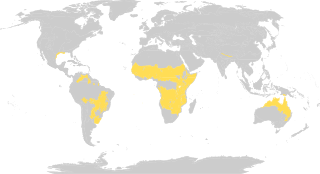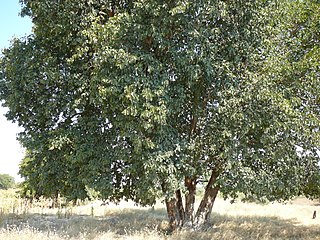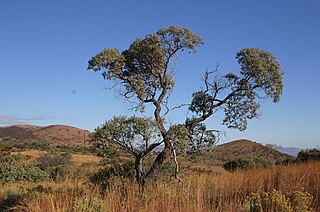
In geography, the temperate or tepid climates of Earth occur in the middle latitudes, which span between the tropics and the polar regions of Earth. These zones generally have wider temperature ranges throughout the year and more distinct seasonal changes compared to tropical climates, where such variations are often small.

Tropical and subtropical grasslands, savannas, and shrublands is a terrestrial habitat type defined by the World Wide Fund for Nature.. The biome is dominated by grass and/or shrubs located in semi-arid to semi-humid climate regions of subtropical and tropical latitudes.

The subtropics are geographic and climate zones located roughly between the tropics at latitude 23.5° and temperate zones north and south of the Equator.

Brachystegia tamarindoides Benth., known as mu'unze and also as the mountain acacia is a medium-sized tree with smooth grey bark, bluish-green leaves and small creamy-white flowers that produce copious amounts of pollen and nectar. It is almost always very close to upturned umbrella shaped with a partially developed flat top, making it easy to recognise in mixed woodland. In this it differs from most of the other Brachystegia species that have variable shapes. The leaves are feathery in appearance, with around 10-12 leaflets arrayed along each leaf stalk.

Diospyros mespiliformis, the jackalberry, is a large dioecious evergreen tree found mostly in the savannas of Africa. Jackals are fond of the fruit, hence the common names. It is a member of the family Ebenaceae, and is related to the true ebony and edible persimmon.

Synsepalum is a genus of trees and shrubs in the chicle family, Sapotaceae described as a genus in 1852.

Baikiaea plurijuga, known as African teak, Mukusi, Rhodesian teak, Zambian teak or Zambesi redwood, is a species of Afrotropical tree from the legume family, the Fabaceae from southern Africa.

The square-tailed nightjar is a species of nightjar in the family Caprimulgidae which is native to tropical and subtropical woodlands of the Afrotropics. It has an extensive range south of the African equator. Despite not having a completely "square tail", its naming highlights a distinguishing field mark. The similarly plumaged slender-tailed nightjar, found in dry bush country of the tropics, differs namely by its protruding central tail feathers. It is alternatively known as the Gabon nightjar or Mozambique nightjar.

Parinari curatellifolia is an evergreen tropical tree of Africa, found in various kinds of deciduous woodland most frequently in poorly drained areas and inland at moderate altitudes. It is also known as mupundu or mobola plum after the fruit, which is considered tasty and causes the tree to be spared when woodland is cleared for cultivation.

Julbernardia globiflora is a tropical African tree widespread at moderate altitudes in Miombo woodland to the south and east of the equatorial forest region of the Congo basin. Its common name is Mnondo. It is ecologically important over wide areas and is dominant to co-dominant in many types of woodland, always being most successful in drier types of deciduous woodland where there is less competition.

The Real fan palm, locally known as the Makalani palm, is a palm tree native to the subtropical, low-lying regions of south central Africa.

Pappea capensis is a South African tree in the family Sapindaceae. It is the only species in the genus Pappea.

Combretum erythrophyllum, commonly known as the river bushwillow, is a medium-sized to large, spreading tree found in bush along river banks in southern Africa. It is planted as a shade and ornamental tree in South Africa and the United States, and is propagated by seed.

Ozoroa paniculosa, commonly known as the bushveld ozoroa or common resin tree, is a small tree belonging to the mango family or Anacardiaceae. It is native to southern Africa, where it occurs in Zimbabwe, South Africa, Mozambique, Botswana and Namibia. It grows to a height of about 6 metres at high elevations, but may reach 15 metres in warmer, low-lying areas. This genus currently has some 28 species and occurs from southern Africa to the Arabian Peninsula.

The Knobbly fig is an African species of cauliflorous fig. It is named after Zanzibar, where Franz Stuhlmann discovered it in 1889. They regularly reach 10 m, but may grow up to 40 m tall as forest stranglers. It occurs in the tropics and subtropics from coastal elevations to 900 m above sea level. They prefer deep sandy soil and often start life as a strangler. The pollinating wasp is Courtella armata.

Euclea crispa, commonly known as the blue guarri, is an Afrotropical plant species of the family Ebenaceae. The hardy and evergreen plants may form a dense stand of shrubs, or grow to tree size. It is widespread and common in the interior regions of southern Africa, and occurs northward to the tropics. Though some are present near the South African south and east coasts, they generally occur at middle to high altitudes. It is readily recognizable from its much-branched structure and dull bluish foliage colour. Those bearing lanceolate leaves may however resemble the Wild olive, another common species of the interior plateaus.

Trichocladus ellipticus is a species in the genus Trichocladus, in the family Hamamelidaceae. It is also called white witch-hazel.

Chrysophyllum viridifolium, commonly known as fluted milkwood, is a potentially large species of evergreen milkwood tree that occurs in East African coastal forests, southerly coastal forest mosaics and in some inland forests of the tropics and subtropics.

Commiphora schimperi, also known as glossy-leaved corkwood, is a tree species in the genus Commiphora, which is native to Namibia, Zimbabwe and northern South Africa.

Odontotermes, commonly known as the fungus-growing termites, is a termite genus belonging to family Termitidae, which is native to the Old World. They are most destructive in wooden homes, and are agricultural pests in the tropics and subtropics of Africa and Asia.























